
In today's fast-paced world, finding time to go to the gym can be a challenge. Between work, family and other commitments, our health often takes a back seat. But what if we told you that you can achieve your fitness goals without leaving the comfort of your home? Welcome to the world of home workouts, a convenient and effective way to get fit. In this comprehensive guide, we'll explore the ins and outs of home workouts and how to build your own gym, providing you with valuable tips, routines, and insights to help you on your journey to better, healthier fitness.
The Benefits of Home Workouts
Before diving into the specifics of home workouts, it's essential to understand the numerous benefits they offer. Here are some of the key advantages of working out at home:
1.Convenience
One of the most significant benefits of home workouts is convenience. You can exercise at any time that suits your schedule, without the need to travel to a gym. No more waiting in line for equipment or dealing with crowded locker rooms.
2.Cost-Effective
Home workouts can save you a substantial amount of money. You don't need to pay for a gym membership, and you can start with minimal equipment or even bodyweight exercises.

3.Privacy
Some people may feel self-conscious about working out in public, especially if they're just starting their fitness journey. Home workouts provide complete privacy and a judgment-free environment.
4.Variety
Home workouts offer a wide range of exercise options. From bodyweight workouts to yoga, there are countless routines available to keep your fitness routine exciting and effective.
5.Time Efficiency
Home workouts eliminate the need for commuting to and from the gym. This time-saving aspect can be a game-changer for those with busy schedules.
How to Build Your Own Gym
Building a home gym takes just a few simple steps: Plan, Buy, Assemble, and Finish. Sounds easy too! But there are many factors to consider.
1.Where to build your home gym
2.Confirm the amount of free space
3.What kind of training do you want to do
4.How to choose home fitness equipment
5.Other family members
6.Buy floor mats
7.Design your home gym
7.Complete your home gym
If you want to know more, click this article👉IFAST Ultimate Guide
Getting Started with Home Workouts

Now that you understand the benefits, let's delve into how to get started with home workouts.
1.Set Clear Goals
Begin by establishing your fitness goals. Do you want to lose weight, gain muscle, improve flexibility, or enhance your cardiovascular health? Defining your objectives will guide your workout choices.
2.Create a Dedicated Space
Designate a specific area in your home for exercise. Having a dedicated workout space helps you stay organized and committed to your fitness routine.
3.Choose the Right Equipment
You don't need a home gym full of equipment to get a great workout. Start with the basics, like resistance bands, dumbbells, a yoga mat, or even just your body weight. As you progress, you can invest in more equipment.
4.Find Suitable Workouts
The internet is a treasure trove of workout routines for all fitness levels. You can explore various YouTube channels, fitness apps, or hire a personal trainer for customized workouts.
5.Create a Schedule
Consistency is key. Set a workout schedule that aligns with your daily routine. Whether it's mornings, evenings, or a quick session during lunch, find a time that works for you.
Popular Home Workout Types
There are numerous workout types you can explore from home, catering to various fitness goals and preferences. Here are some of the most popular ones:
1.Bodyweight Workouts

Bodyweight exercises, such as push-ups, squats, and planks, are fantastic for building strength and improving endurance without any equipment.
2.Yoga

Yoga is excellent for enhancing flexibility, balance, and mental well-being. It's suitable for all fitness levels, and you can find a wide range of online classes.
3.High-Intensity Interval Training (HIIT)

HIIT workouts are known for their efficiency. They involve short, intense bursts of exercise followed by brief rest periods. HIIT is excellent for burning calories and improving cardiovascular fitness.
4.Strength Training

You can build muscle and strength at home with the right equipment. Dumbbells, resistance bands, or kettlebells can be used for various strength training exercises.
5.Cardio Workouts

If you want to get your heart rate up, there are plenty of cardio options available. Try dancing, jumping jacks, or even indoor cycling on a stationary bike.
Sample Home Workout Routines
Let's explore some sample home workout routines, catering to different fitness goals:
1.Beginner's Bodyweight Workout
- Warm-up: 5 minutes of light cardio (e.g., jumping jacks or jogging in place)
- Push-ups—3 sets of 10 reps
- Bodyweight squats—3 sets of 12 reps
- Plank—3 sets of 30 seconds
- Cool-down—Stretching exercises for 5 minutes
2.Yoga for Stress Relief
- Sun Salutations—3 rounds
- Downward-Facing Dog—Hold for 1 minute
- Child's Pose—Hold for 1 minute
- Warrior II Pose—30 seconds each side
- Corpse Pose (final relaxation)—5 minutes
3.Full-Body HIIT Workout
- Jumping jacks—1 minute
- Push-ups—1 minute
- Squat jumps—1 minute
- High knees—1 minute
- Rest—1 minute (repeat the circuit 3 times)
4.Dumbbell Strength Training
- Goblet squats—3 sets of 12 reps
- Dumbbell lunges—3 sets of 10 reps per leg
- Bent-over rows—3 sets of 12 reps
- Dumbbell chest press—3 sets of 10 reps
5.Cardio Blast
- Jump rope—3 minutes
- Burpees—1 minute
- Mountain climbers—1 minute
- Rest—1 minute (repeat the circuit 3 times)
Progressing in Your Home Workouts

As you get comfortable with your home workout routine, it's essential to progress and challenge yourself. Here's how you can do that:
1.Increase Intensity
Gradually increase the intensity of your workouts by adding more repetitions, sets, or time. This helps you continue to make progress.
2.Try Advanced Exercises
Once you've mastered the basics, explore more advanced exercises to keep your workouts engaging and effective.
3.Mix It Up
Variety is essential for preventing boredom and plateaus. Incorporate different types of workouts to target various muscle groups and fitness aspects.
4.Set New Goals
Regularly set new fitness goals to keep yourself motivated. Whether it's improving your running time, increasing your flexibility, or adding more weight in strength training, having goals keeps you focused.
5.Listen to Your Body
Lastly, always listen to your body. If you're feeling fatigued or experiencing pain beyond regular muscle soreness, it's essential to rest and recover. Overtraining can lead to injuries and burnout.
Staying Motivated
Staying motivated during home workouts can be challenging, but it's essential for long-term success. Here are some tips to keep you on track:
Find a Workout Buddy: Having a workout partner can be motivating and make exercising more fun, even if it's virtually over a video call.
Set Rewards: Treat yourself when you hit fitness milestones. Rewards can be powerful motivators.
Track Your Progress: Keep a workout journal to see how far you've come. It's rewarding to look back and see your improvements.
Join Virtual Classes: Many fitness trainers offer virtual classes. Joining a live class can make you feel like you're part of a community.
Stay Consistent: Make your workouts a non-negotiable part of your routine. Consistency is key to achieving your fitness goals.
Final Thoughts
Home workouts offer a convenient, cost-effective, and efficient way to achieve your fitness goals. Whether you're a beginner or a fitness enthusiast, there's a home workout routine that can work for you. Remember to set clear goals, create a dedicated workout space, choose the right equipment, and find suitable workouts. With dedication, consistency, and the right mindset, you can embark on a successful fitness journey from the comfort of your home. So, why wait? Get started on your path to a healthier, fitter you today.


